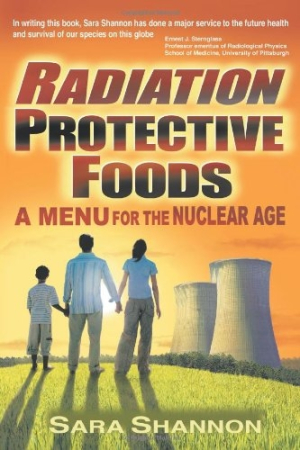Radiation Protective Foods
A Menu for the Nuclear Age
In 1986, Sara Shannon published Diet for the Atomic Age, which outlined the hazards of low-level radiation on human health. Since that time there have been many more nuclear power plants and nuclear waste sites constructed across the globe. With the radiation releases caused by the post-tsunami accidents at Fukushima in Japan in 2011 and the continued concerns many have over the safety of nuclear energy, it is very timely that this book is now updated, published under the title Radiation Protective Foods: A Menu for the Nuclear Age.
This revised edition of Shannon’s public-health classic lays out the possible impacts of these increased radiation levels, from weakened immune systems to lower fertility rates. The author consistently underscores the idea that there is no safe level of radiation. Undoubtedly, long-term radiation exposure leads to adverse health effects. She also notes that human sensitivity to radiation varies among individuals, so that one’s best defense against these cumulative impacts is to shield the body from harm through a specific healthy-eating regimen.
Shannon has a direct writing style, and she patiently explains many complicated and technical subjects to help the reader understand how low-level radiation affects cellular processes. There are sometimes interjections of strong opinion, as when she writes of “death-dealing” nuclear plants, but on the whole, Shannon’s assertions are clear, authoritative, and backed up with many examples of scientific research.
The chief deficiency of this book, however, is that much of the cited material is outdated. Accepted blood lead levels have been much revised since 1986, and descriptions of Star Wars technology, Pac-man video games, and a recent AIDS epidemic make the book feel far from updated. Today’s readers would find it valuable to learn about recent research concerning possible links between low-level radiation and increasing levels of autism, food allergies, and attention deficit disorder in North America, or the health hazards of radiation emanating from the profusion of electronic devices that consumers use in the twenty-first century.
It also appears that whole sections of this expanded edition of Diet for the Atomic Age were digitally scanned from the first edition, judging by the grainy reproduction of maps and other illustrations and the frequency of peculiar typos, which seem to occur when certain letters are mistaken for others (“cl” turns into “d,” and “rn” looks like “m,” for example).
At its core, however, Shannon’s book is a valuable reference for readers who want more information about how to avoid foods that weaken the body’s defenses and maintain a diet that helps flush out harmful substances. With more current research findings and some light copy editing, this volume would be a great bookshelf addition for anyone concerned about how to protect themselves and their loved ones from the harmful impacts of low-level radiation.
Reviewed by
Rachel Jagareski
Disclosure: This article is not an endorsement, but a review. The publisher of this book provided free copies of the book and paid a small fee to have their book reviewed by a professional reviewer. Foreword Reviews and Clarion Reviews make no guarantee that the publisher will receive a positive review. Foreword Magazine, Inc. is disclosing this in accordance with the Federal Trade Commission’s 16 CFR, Part 255.

